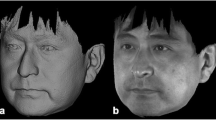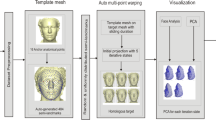Abstract
Decomposition of the human body and human face is influenced, among other things, by environmental conditions. The early decomposition changes that modify the appearance of the face may hamper the recognition and identification of the deceased. Quantitative assessment of those changes may provide important information for forensic identification. This report presents a pilot 3D quantitative approach of tracking early decomposition changes of a single cadaver in controlled environmental conditions by summarizing the change with weekly morphological descriptions. The root mean square (RMS) value was used to evaluate the changes of the face after death. The results showed a high correlation (r = 0.863) between the measured RMS and the time since death. RMS values of each scan are presented, as well as the average weekly RMS values. The quantification of decomposition changes could improve the accuracy of antemortem facial approximation and potentially could allow the direct comparisons of antemortem and postmortem 3D scans.



Similar content being viewed by others
References
Janaway RC, Percival SL, Wilson AS (2008) Decomposition of human remains. In: Percival SL (ed) Microbiology and aging. Clinical Manifestations. Springer Science & Business Media, Berlin, pp 313–335
Hayman J, Oxenham M (2016) Human body decomposition. Academic Press, Cambridge
DiMaio D, Dimaio VJM (2001) Forensic pathology, Second edn. CRC Press, Boca Raton
Galloway A, Birkby WH, Jones AM, Henry TW, Parks BO (1989) Decay rates of human remains in an arid environment. J Forensic Sci 34(3):607–616
Voss SC, Forbes SL, Dadour IR (2008) Decomposition and insect succession on cadavers inside a vehicle environment. Forensic Sci Med Pathol 4(1):22–32
Goff ML (2009) Early post-mortem changes and stages of decomposition in exposed cadavers. Exp Appl Acarol 49(1):21–36
Haglund WD, Sorg MH (2001) Human remains in water environments. In: Haglund WD, Sorg MH (eds) Advances in forensic taphonomy: method, theory, and archaeological perspectives. CRC Press, Boca Raton, pp 202–216
Schotsmans EMJ, Van de Voorde W, De Winne J, Wilson AS (2011) The impact of shallow burial on differential decomposition to the body: a temperate case study. Forensic Sci Int 206(1–3):e49–e48
Wilkinson C, Rynn C (2012) Craniofacial identification. Cambridge University Press, Cambridge
Wilkinson C, Tillotson A (2012) Post-mortem prediction of facial appearance. In: Wilkinson C, Rynn C (eds) Craniofacial identification. Cambridge University Press, Cambridge, pp 166–183
Gibelli DM, De Angelis D, Poppa P, Sforza C, Cattaneo C (2016) A view to the future: a novel approach for 3D-3D superimposition and quantification of differences for identification from next-generation video surveillance systems. J Forensic Sci 62(2):457–461
Codari M, Pucciarelli V, Stangoni F, Zago M, Tarabbia F, Biglioli F, Sforza C (2017) Facial thirds–based evaluation of facial asymmetry using stereophotogrammetric devices: application to facial palsy subjects. J Craniomaxillofac Surg 45(1):76–81
Taylor HO, Morrison CS, Linden O, Phillips B, Chang J, Byrne ME, Sullivan SR, Forrest CR (2014) Quantitative facial asymmetry: using three-dimensional photogrammetry to measure baseline facial surface symmetry. J Craniofac Surg 25:124–128
Katina S, McNeil K, Ayoub A, Guilfoyle B, Khambay B, Siebert P, Sukno F, Rojas M, Vitter L, Waddington J, Whelan PF, Bowman AW (2015) The definitions of three-dimensional landmarks on the human face: an interdisciplinary view. J Anat 228(3):355–365
Anderson-Darling Normality Test calculator. http://www.kevinotto.com/RSS/templates/Anderson-Darling Normality Test Calculator.xls. Accessed 30 March 2017
Rho NK, Park JY, Youn CS, Lee SK, Kim HS (2017) Early changes in facial profile following structured filler rhinoplasty: an anthropometric analysis using a 3-dimensional imaging system. Dermatol Surg 43(2):255–263
Ogawa Y, Taniguchi K, Imaizumi K, Miyasaka S (2016) Discussion of photo anthropometrical method using three dimensional facial images. Jpn J Forens Sci Technol 21(1):95–108
OECD (2015) Medical technologies. In: Health at a glance 2015: OECD indicators. OECD Publishing, Paris, pp 102–103
Acknowledgements
Research received funding by the Department of Biomedical Sciences for Health, Università degli Studi di Milano (15-6-3016000-205).
Author information
Authors and Affiliations
Corresponding author
Rights and permissions
About this article
Cite this article
Caplova, Z., Gibelli, D.M., Poppa, P. et al. 3D quantitative analysis of early decomposition changes of the human face. Int J Legal Med 132, 649–653 (2018). https://doi.org/10.1007/s00414-017-1647-x
Received:
Accepted:
Published:
Issue Date:
DOI: https://doi.org/10.1007/s00414-017-1647-x




